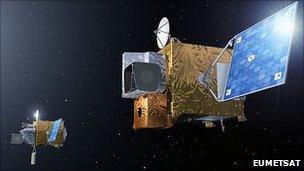Meteosat 拢2.9bn weather satellite programme approved
- Published

The first MTGs will launch later this decade
The all clear has been given for Europe to press ahead with the 3.4bn-euro (拢2.9bn) project to build a next-generation weather satellite system.
Eumetsat, the international agency charged with looking after Europe's Meteosats, said on Friday that all participating nations had now agreed to the programme and its financing.
The new system should bring a step change in weather forecasting capability, guaranteeing European access to space-acquired meteorological data until at least the late 2030s.
Full approval has come thanks to a decision by Belgium's caretaker government to support the project financially. The nation has not had a ruling administration since a general election in June, and was unable to commit the necessary funds when asked to do so at a meeting of the 26-nation Eumetsat organisation in December.
But the caretaker government has now indicated that Belgium will honour its commitments and this has allowed the Meteosat Third Generation (MTG) programme to go into full implementation.
Belgium was not the only member state in Eumetsat to have difficulty in meeting the costs of MTG. Portugal, with its vast public debts, also struggled to meet the timetable for implementation, and only came onboard in recent weeks.
Eumetsat Director-General, Dr Lars Prahm, welcomed the news: "It was not an easy process and the overall financial situation in Europe certainly did not help but I am very pleased to see that all member states have now approved a vital programme which will assure the future of Eumetsat's geostationary observations over Europe, Africa and the Atlantic Ocean over the next few decades."
MTG will be one of the biggest and the most complex space projects ever undertaken in Europe.
It will be run as a joint undertaking between Eumetsat and the European Space Agency (Esa)
The latter will act as the R&D partner, developing the technology. The former will then operate the space platforms.
MTG will comprise six satellites in total, with the first spacecraft likely to be ready to enter service in 2018.
The platforms will be of two types: an imaging spacecraft to picture weather systems, and a sounding spacecraft (one which can return information about different layers in the atmosphere).
They will be quite unlike their forebears - the second-generation satellites (MSG) that provide weather data today.
For example, MSG satellites are spin-stabilised and build up their images as they rotate across the field of view.
The MTG spacecraft, on the other hand, will look more like standard telecommunications platforms. They will sit and stare at the Earth.
Their image data will have a much higher resolution (capturing details as small as 500m across) and will come down to the ground in a fraction of the time - in as little as 2.5 minutes.
The new spacecraft will also carry many innovations that should translate into more accurate and more detailed weather forecasts.
One key development is an Infrared Sounding Instrument that has been pioneered on Europe's Metop polar-orbiting Earth-observation spacecraft but which will now be flown in a geostationary orbit by MTG 36,000km above the planet.
The instrument will be able to detect layers of moisture in the atmosphere long before they have developed into weather systems.
- Published13 December 2010
- Published19 November 2010